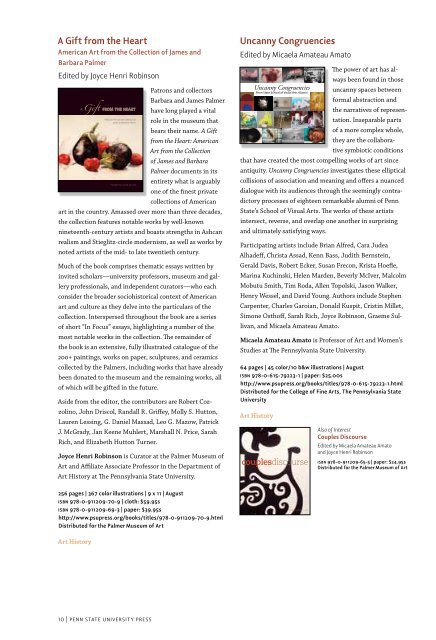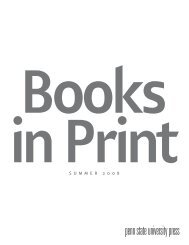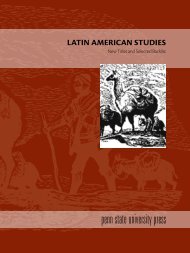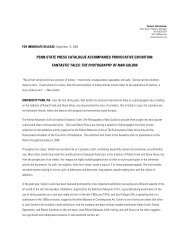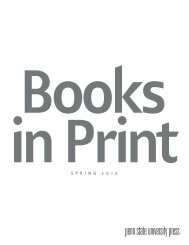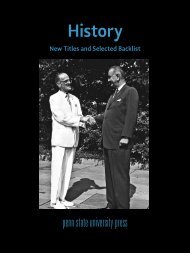Download the Catalog - Pennsylvania State University Press
Download the Catalog - Pennsylvania State University Press
Download the Catalog - Pennsylvania State University Press
Create successful ePaper yourself
Turn your PDF publications into a flip-book with our unique Google optimized e-Paper software.
isbn 0-911209-65-4<br />
9 7 8 0 9 1 1 2 0 9 6 5 5<br />
9 0 0 0 0<br />
A Gift from <strong>the</strong> Heart<br />
American Art from <strong>the</strong> Collection of James and<br />
Barbara Palmer<br />
Edited by Joyce Henri Robinson<br />
Patrons and collectors<br />
Barbara and James Palmer<br />
have long played a vital<br />
role in <strong>the</strong> museum that<br />
bears <strong>the</strong>ir name. A Gift<br />
from <strong>the</strong> Heart: American<br />
Art from <strong>the</strong> Collection<br />
of James and Barbara<br />
Palmer documents in its<br />
entirety what is arguably<br />
one of <strong>the</strong> finest private<br />
collections of American<br />
art in <strong>the</strong> country. Amassed over more than three decades,<br />
<strong>the</strong> collection features notable works by well-known<br />
nineteenth-century artists and boasts strengths in Ashcan<br />
realism and Stieglitz-circle modernism, as well as works by<br />
noted artists of <strong>the</strong> mid- to late twentieth century.<br />
Much of <strong>the</strong> book comprises <strong>the</strong>matic essays written by<br />
invited scholars—university professors, museum and gallery<br />
professionals, and independent curators—who each<br />
consider <strong>the</strong> broader sociohistorical context of American<br />
art and culture as <strong>the</strong>y delve into <strong>the</strong> particulars of <strong>the</strong><br />
collection. Interspersed throughout <strong>the</strong> book are a series<br />
of short “In Focus” essays, highlighting a number of <strong>the</strong><br />
most notable works in <strong>the</strong> collection. The remainder of<br />
<strong>the</strong> book is an extensive, fully illustrated catalogue of <strong>the</strong><br />
200+ paintings, works on paper, sculptures, and ceramics<br />
collected by <strong>the</strong> Palmers, including works that have already<br />
been donated to <strong>the</strong> museum and <strong>the</strong> remaining works, all<br />
of which will be gifted in <strong>the</strong> future.<br />
Aside from <strong>the</strong> editor, <strong>the</strong> contributors are Robert Cozzolino,<br />
John Driscol, Randall R. Griffey, Molly S. Hutton,<br />
Lauren Lessing, G. Daniel Massad, Leo G. Mazow, Patrick<br />
J. McGrady, Jan Keene Muhlert, Marshall N. Price, Sarah<br />
Rich, and Elizabeth Hutton Turner.<br />
Joyce Henri Robinson is Curator at <strong>the</strong> Palmer Museum of<br />
Art and Affiliate Associate Professor in <strong>the</strong> Department of<br />
Art History at The <strong>Pennsylvania</strong> <strong>State</strong> <strong>University</strong>.<br />
256 pages | 367 color illustrations | 9 x 11 | August<br />
isbn 978-0-911209-70-9 | cloth: $59.95s<br />
isbn 978-0-911209-69-3 | paper: $39.95s<br />
http://www.psupress.org/books/titles/978-0-911209-70-9.html<br />
Distributed for <strong>the</strong> Palmer Museum of Art<br />
Art History<br />
AGift FROM THE HEART<br />
American Art from <strong>the</strong> Collection of<br />
James and Barbara Palmer<br />
PALMER MUSEUM OF ART<br />
couplesdiscourse palmer museum of art<br />
Uncanny Congruencies<br />
Edited by Micaela Amateau Amato<br />
The power of art has always<br />
been found in those<br />
Uncanny Congruencies uncanny spaces between<br />
Penn <strong>State</strong> School of Visual Arts Alumni<br />
formal abstraction and<br />
<strong>the</strong> narratives of representation.<br />
Inseparable parts<br />
of a more complex whole,<br />
<strong>the</strong>y are <strong>the</strong> collaborative<br />
symbiotic conditions<br />
that have created <strong>the</strong> most compelling works of art since<br />
antiquity. Uncanny Congruencies investigates <strong>the</strong>se elliptical<br />
collisions of association and meaning and offers a nuanced<br />
dialogue with its audiences through <strong>the</strong> seemingly contradictory<br />
processes of eighteen remarkable alumni of Penn<br />
<strong>State</strong>’s School of Visual Arts. The works of <strong>the</strong>se artists<br />
intersect, reverse, and overlap one ano<strong>the</strong>r in surprising<br />
and ultimately satisfying ways.<br />
Participating artists include Brian Alfred, Cara Judea<br />
Alhadeff, Christa Assad, Kenn Bass, Judith Bernstein,<br />
Gerald Davis, Robert Ecker, Susan Frecon, Krista Hoefle,<br />
Marina Kuchinski, Helen Marden, Beverly McIver, Malcolm<br />
Mobutu Smith, Tim Roda, Allen Topolski, Jason Walker,<br />
Henry Wessel, and David Young. Authors include Stephen<br />
Carpenter, Charles Garoian, Donald Kuspit, Cristin Millet,<br />
Simone Osthoff, Sarah Rich, Joyce Robinson, Graeme Sullivan,<br />
and Micaela Amateau Amato.<br />
Micaela Amateau Amato is Professor of Art and Women’s<br />
Studies at The <strong>Pennsylvania</strong> <strong>State</strong> <strong>University</strong>.<br />
64 pages | 45 color/10 b&w illustrations | August<br />
isbn 978-0-615-79223-1 | paper: $25.00s<br />
http://www.psupress.org/books/titles/978-0-615-79223-1.html<br />
Distributed for <strong>the</strong> College of Fine Arts, The <strong>Pennsylvania</strong> <strong>State</strong><br />
<strong>University</strong><br />
Art History<br />
couplesdiscourse<br />
palmer museum of art<br />
Also of Interest<br />
Couples Discourse<br />
Edited by Micaela Amateau Amato<br />
and Joyce Henri Robinson<br />
isbn 978-0-911209-65-5 | paper: $24.95s<br />
Distributed for <strong>the</strong> Palmer Museum of Art<br />
Beyond <strong>the</strong> Aes<strong>the</strong>tic and <strong>the</strong> Anti-<br />
Aes<strong>the</strong>tic<br />
Edited by James Elkins<br />
Each of <strong>the</strong> five volumes<br />
t h e s t o n e a r t t h e o r y i n s t i t u t e s : v o l u m e f o u r<br />
in <strong>the</strong> Stone Art Theory<br />
Institutes series—and<br />
BEYOND<br />
<strong>the</strong> seminars on which<br />
THE AESTHETIC<br />
<strong>the</strong>y are based—brings<br />
AND THE<br />
toge<strong>the</strong>r a range of scholars<br />
who are not always<br />
ANTI-AESTHETIC<br />
directly familiar with<br />
one ano<strong>the</strong>r’s work. The<br />
Edited by James Elkins<br />
outcome of each of <strong>the</strong>se<br />
convergences is an extensive<br />
and “unpredictable<br />
conversation” on knotty<br />
and provocative issues about art. This fourth volume in <strong>the</strong><br />
series, Beyond <strong>the</strong> Aes<strong>the</strong>tic and <strong>the</strong> Anti-Aes<strong>the</strong>tic, focuses<br />
on questions revolving around <strong>the</strong> concepts of <strong>the</strong> aes<strong>the</strong>tic,<br />
<strong>the</strong> anti-aes<strong>the</strong>tic, and <strong>the</strong> political. The book is about <strong>the</strong><br />
fact that now, almost thirty years after Hal Foster defined<br />
<strong>the</strong> anti-aes<strong>the</strong>tic, <strong>the</strong>re is still no viable alternative to <strong>the</strong><br />
dichotomy between aes<strong>the</strong>tics and anti- or non-aes<strong>the</strong>tic<br />
art. The impasse is made more difficult by <strong>the</strong> proliferation<br />
of identity politics, and it is made less negotiable by <strong>the</strong><br />
hegemony of anti-aes<strong>the</strong>tics in academic discourse on art.<br />
The central question of this book is whe<strong>the</strong>r artists and<br />
academicians are free of this choice in practice, in pedagogy,<br />
and in <strong>the</strong>ory.<br />
The contributors are Stéphanie Benzaquen, J. M. Bernstein,<br />
Karen Busk-Jepsen, Luis Camnitzer, Diarmuid<br />
Costello, Joana Cunha Leal, Angela Dimitrakaki, Alexander<br />
Dumbadze, T. Brandon Evans, Geng Youzhuang, Boris<br />
Groys, Beáta Hock, Gordon Hughes, Michael Kelly, Grant<br />
Kester, Meredith Kooi, Cary Levine, Sunil Manghani, William<br />
Mazzarella, Justin McKeown, Andrew McNamara, Eve<br />
Meltzer, Nadja Millner-Larsen, Maria Filomena Molder,<br />
Carrie Noland, Gary Peters, Aaron Richmond, Lauren<br />
Ross, Toni Ross, Eva Schürmann, Gregory Sholette, Noah<br />
Simblist, Jon Simons, Robert Storr, Martin Sundberg,<br />
Timo<strong>the</strong>us Vermeulen, and Rebecca Zorach.<br />
James Elkins is E. C. Chadbourne Professor in <strong>the</strong> Department<br />
of Art History, Theory, and Criticism at <strong>the</strong> School of<br />
<strong>the</strong> Art Institute of Chicago.<br />
224 pages | 2 illustrations | 7 x 10 | September<br />
isbn 978-0-271-06072-9 | cloth: $74.95s<br />
http://www.psupress.org/books/titles/978-0-271-06072-9.html<br />
The Stone Art Theory Institutes Series #4<br />
Art History/Aes<strong>the</strong>tics<br />
Architecture and <strong>State</strong>craft<br />
Charles of Bourbon’s Naples, 1734–1759<br />
Robin L. Thomas<br />
“Thomas’s account thrusts<br />
Robin L. Thomas<br />
eighteenth-century<br />
Neapolitan architecture<br />
to <strong>the</strong> forefront of Italian<br />
baroque scholarship.<br />
Through <strong>the</strong>se chapters<br />
architecture and statecraft<br />
Charles of Bourbon’s Naples, 1734–1759<br />
we see <strong>the</strong> building arts of<br />
Naples take <strong>the</strong>ir rightful<br />
place among <strong>the</strong> most<br />
glorious achievements<br />
in Italy, comparable in<br />
every way to <strong>the</strong> storied chapters from Rome, Venice, and<br />
<strong>the</strong> Piedmont. In sum, Robin Thomas has set a remarkable<br />
standard for graceful writing, substantial research, and perceptive<br />
insight in a book that provides a rich and engrossing<br />
account of Naples in its full glory.”<br />
<br />
—Tod Marder, Rutgers <strong>University</strong><br />
The eighteenth century was a golden age of public building.<br />
Governments constructed <strong>the</strong>aters, museums, hospices,<br />
asylums, and marketplaces to forge a new type of city,<br />
one that is recognizably modern. Yet <strong>the</strong> dawn of this<br />
urban development remains obscure. In Architecture and<br />
<strong>State</strong>craft, Robin Thomas seeks to explain <strong>the</strong> origins of <strong>the</strong><br />
modern capital by examining one of <strong>the</strong> earliest of <strong>the</strong>se<br />
transformed cities. In 1737 <strong>the</strong> Spanish-born King Charles<br />
of Bourbon embarked upon <strong>the</strong> largest and most extensive<br />
architectural and urban program of <strong>the</strong> entire century. A<br />
comprehensive study of <strong>the</strong>se Neapolitan buildings does<br />
not exist, and thus Caroline contributions to this new type<br />
of city remain undervalued. This book fills an important<br />
gap in <strong>the</strong> scholarship and connects Charles’s urban<br />
improvements to his consolidation of <strong>the</strong> monarchy. By intertwining<br />
architecture and sovereignty, Thomas provides<br />
a framework for understanding how politics created <strong>the</strong><br />
eighteenth-century capital.<br />
Robin L. Thomas is Assistant Professor of Art History at<br />
The <strong>Pennsylvania</strong> <strong>State</strong> <strong>University</strong>.<br />
248 pages | 120 illustrations | 9 x 10 | May<br />
isbn 978-0-271-05639-5 | cloth: $89.95s<br />
http://www.psupress.org/books/titles/978-0-271-05639-5.html<br />
Buildings, Landscapes, and Societies Series<br />
Architecture<br />
_<br />
10 | penn state university press 1-800-326-9180 | 11


